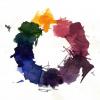Search the Community
Showing results for tags 'robert oster sydney lavender'.
-
So in my head under the banner "violet" you have those tending blue and those tending red (plus a lot of strange words such as mauve and purple whose meaning seems hard to pin down exactly?). Rohrer & Klingner's Scabiosa was and is my first love. I have always been fascinated by how the fresh ink goes down blue-violet then dries to red-violet, which echoes so many flower aging processes besides its namesake, but also a little disapointed that the original color is, to me, more attractive than the end result. In my first go through an inky color wheel I had Blue Myotosis and Diamine Tyrian Purple in the blue and red violet slots. With more experience, I have started to distinguish paint colors (which can be pure and bright for mixing) from ink colors (which I prefer darker and more subdued for general writing). Time to look at those violets again? On my first go at seeing what I had I was surprised to find that I seem to be buying inks in the "mid-violet" range over and over, even though in my head blue-violet is preferred. I had full size bottles of Scabiosa (including one in reserve!), Sailor Chu Shu and Birmingham Lilac Wind, all of which were really quite similar. I enjoy Robert Oster's Summer Storm (which I have renamed "Soft Snow of Australia", as for me it is a Winter ink), but either side of this central band was really rather weak. Back to the ink stores I go! After a rather nerve-wracking choice of Robert Oster's Sydney Lavender and Claret to fill the slots. Heres what the first splodgy page looked like (the left edge being Summer Storm, Sydney Lavender & Claret.): OK - so these scans are horribly inaccurate compared to my eyes, but hopefully they do show the relative differences. A simple initial arrangement of a sequence of five: Which, once my sample of Violet Starling arrived, is expanded as follows: . . . . with a finer nib: . . . so the blue and the red ends seem clear, it's those middle four that are subtle: . . . which is a particularly ghastly scan, presumably through its lack of contrast, to my eyes everything is much pinker, but the relative values are correct. Back to my original thesis then, here's a final three: Obviously this is not intended to be exhaustive or comprehensive, just my own personal choices in digging at a general theme. I would love to hear (and see examples!) of other inks in each of these three adjacent color areas (or other systems for dividing them up).

